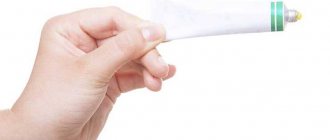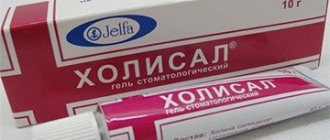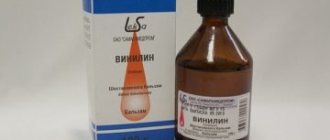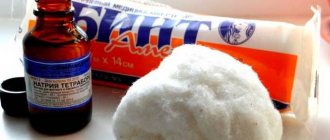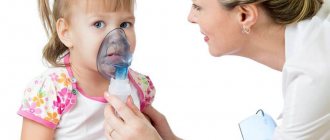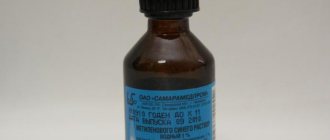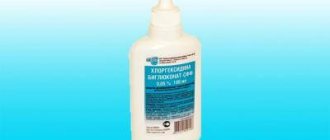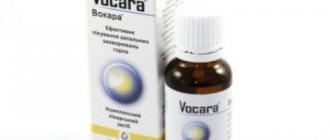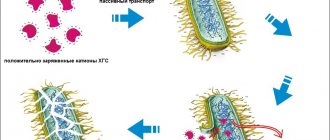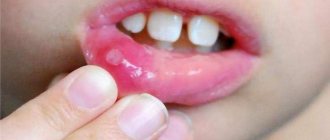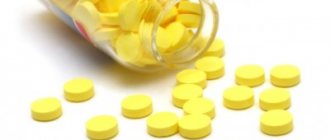How is stomatitis treated with Viferon?
The medicine for each patient, as well as recommendations for the therapeutic course, are prescribed by the doctor, based on the examination, general condition and age of the patient. Gels and ointments are prescribed for severe pain. These forms are considered the most effective in direct contact with open wounds and are characterized by analgesic properties.
Gels and ointments are easy to treat affected areas and evenly distribute the composition over problem areas.
In dentistry, this pharmaceutical drug is used mainly to eliminate herpetic stomatitis. Many people overlook one important point - inflammation of the epithelium of the mucous membrane can be triggered by bacteria or allergies. In these cases, the use of antiviral drugs (which include Viferon) is fraught with a deterioration in the patient’s well-being.
The therapeutic course can be either systemic or local. Taking this into account, the following forms of medication are prescribed for the treatment of chronic or acute herpetic stomatitis:
- rectal suppositories are the best option for infants and young children;
- ointment - suitable for all patients if the disease is localized on the lips or skin;
- gel is the optimal choice for inflammation of the mucous membrane and mouth ulcers.
The latter form is considered universal because it is suitable for all ages and provides relief from the disease in a few days.
Herpetic stomatitis
Acute stomatitis is treated with antiviral drugs. If we are talking about a chronic form of the disease, then complex therapy is carried out including immunomodulators. Medicines against herpes are produced in the form of gels, creams, ointments and suppositories. Creams and ointments are used for external treatment of inflammation.
Viferon gel for stomatitis is prescribed in cases where we are talking about lesions of the mucous membrane localized in the oral cavity. The main active ingredient of the drug is interferons with pronounced antiviral and immune-stimulating effects, “working” in conjunction with vitamins C and E.
Often, to eliminate the disease, drug treatment is supplemented with lotions and rinses. Many children under the age of 3 have problems with mouth rinsing, so for them, a gel is the best way out of the situation.
Viferon for stomatitis in children
Effective treatment of stomatitis in children involves targeted local exposure and regular rinsing of the mouth. But since a child is often unable to rinse his mouth independently before the age of 3, doctors have to limit themselves to only medicinal components. In such cases, Viferon gel outperforms most ointments for a number of reasons:
- the composition of the gel is characterized by an analgesic effect;
- the medication quickly cleanses the mucous membrane of necrotic tissue;
- the drug actively inhibits pathogenic viral cells;
- activates regeneration of both the mucous membrane and damaged epithelium.
The gel is much preferable to ointment also because it acts directly on the lesions; the course of treatment for herpetic stomatitis ranges from 5 to 10 days. In children, the ointment does not have time to “fix” on the problem area, since it is absorbed extremely slowly, it is often simply licked off by the child. The gel acts directly on the lesions of the mucous membrane, immediately after application.
Viferon ointment for stomatitis in children and adults
Viferon ointment for stomatitis is used quite often and is recommended by doctors.
Stomatitis refers to inflammation of the oral cavity, accompanied by unpleasant symptoms and sensations. In this case, both children and adults are susceptible to the disease. Symptoms include ulcers and yellow or white plaque. Below we will look at what this ointment consists of, what its features are, and how it can be used correctly for patients of different ages.
Are such ointments useful?
As a rule, a specialist prescribes Viferon if you need to relieve pain due to stomatitis. The use of ointment will speed up recovery, as its components fight infection upon contact with ulcers. In addition, ointments, in addition to local action, can relieve pain symptoms and are convenient to apply. Ointments can be used not only at home.
Stomatitis is divided into several types, so in general, for each patient, it is necessary to take into account the characteristics of his condition, the likelihood of allergies, etc.
Properties of Viferon ointment
Externally, the drug is a viscous substance of a white-yellow hue. At the same time, the ointment has a lanolin smell. The active ingredient in Viferon is interferon alpha-2. The ointment contains peach oil, petroleum jelly, ascorbic acid, lanolin, and water.
Additional elements of the ointment increase the ease of application and distribution of the ointment over the affected surface. The ointment has a pronounced antiviral effect, strengthens the immune system, and has an antiproliferative effect.
The overall effect of all components of the ointment complements its healing properties. For example, vitamin E serves to increase the ability of the active component to boost immunity, fights inflammation, is a membrane stabilizer, and has a restorative effect. Ascorbic acid strengthens the immune system at the local level and also prevents inflammation. The use of vitamins for stomatitis can speed up treatment.
Description of the drug
Viferon gel has all the advantages characteristic of liniment, but provides much better results due to rapid absorption by the problem area (it has a “lighter” glycerin base). The ointment is made on a Vaseline basis, it is denser and thicker in consistency.
Viferon gel is actively used for the treatment of stomatitis in both adults and children.
Gel Viferon can be used for preventive purposes. It is prescribed during pregnancy, breastfeeding and infants under 1 year of age. For the form in question there are no age criteria or restrictions on use.
Clinical and pharmacological group
Viferon is an interferon and belongs to the therapeutic group of MIBP-cytokines. The drug is characterized by a pronounced antiviral and immunomodulatory effect. The components of the medication suppress the activity of herpes viruses (Herpes Simplex) and stimulate the phagocytic function of neutrophils in problem areas.
pharmachologic effect
The high effectiveness of the pharmaceutical agent in the fight against herpetic diseases of the oral cavity is due to the activity and interaction of several active substances at once.
- Interferon type alpha-2b is characterized by immunomodulatory properties: it forms increased cytotoxicity of lymphocytes to pathogenic cells, enhances the phagocytic activity of macrophages. Prevents the replication of DNA that contains viral agents.
- Alpha tocopherol acetate – increases the resistance of healthy cells to viral microorganisms by stabilizing their membrane structure. The antioxidant in question quickly eliminates swelling and triggers regenerative biochemical processes.
- Ascorbic acid increases the efficiency of the patient’s immune system and accelerates the body’s response to viral agents. The effect is achieved by increasing the secretion of class A immunoglobulins.
The drug helps reduce therapeutic doses of hormonal and antibacterial medications during complex therapy. The gel form allows you to prolong the action of the components.
Action of Viferon
The drug Viferon is produced in three forms for medical use:
- gel;
- ointment;
- suppositories for insertion into the rectum.
To treat damage to the mucous membranes, a local gel and suppositories are used, which provide a systemic effect of interferon equivalent to injection. For stomatitis, Viferon ointment is not used, since it is intended for application to the skin and not to the surface of the mucous membrane.
The use of Viferon in the form of a gel provides a local effect in the area of application and prevents the area of inflammation from being limited when used until the bubbles open. The depth of penetration of the drug into the tissue is limited, and the gel itself, when applied to the mucous membrane, can spread and be washed off from the application area, therefore, when the mucous membrane is affected, it must be used more often than for skin manifestations of herpes.
The use of Viferon in the form of rectal suppositories ensures the penetration of interferon into the blood and its systemic effect in distant foci of infection, which can be compared with the injection of the drug.
Viferon is used for mild cases of the disease and for moderate severity of clinical manifestations of herpetic infection.
Release form and composition
The gel is a gel-like opaque mass with a uniform consistency of medium viscosity. The composition has a white-gray tint. Available in 12 ml aluminum tubes and polystyrene jars of the same volume. The pharmaceutical product is supplied in cardboard boxes and includes instructions for use.
Composition of the drug, 1 g:
- Alpha-tocopherol acetate
interferon Alpha-2b (recombinant type) – 36,000 IU – main active ingredient; - methionine – 1.2 mg;
- sodium chloride – 4 mg;
- alpha-tocopherol acetate – 55 mg;
- ethanol – 55 mg;
- carmellose sodium – 20 mg;
- glycerol – 20 mg.
Due to the targeted effect, the gel helps to increase the concentration of secretory antibodies (IgA), thereby ensuring a prolonged therapeutic effect.
Review of the most popular and best drugs
Effective tablets for stomatitis in the mouth can be of complex action. Most tablet drugs have several types of effects simultaneously:
- anesthetic, pain reliever;
- anti-inflammatory;
- antiseptic and disinfectant;
- antiviral;
- antifungal;
- bactericidal, antimicrobial, antibiotic;
- antihistamine;
- regenerative and wound healing;
- strengthening and healing, immunostimulating.
However, there are also drugs that have one specific pronounced effect on areas of inflammation
Painkillers for stomatitis
Hexoral Tabs are lozenges that begin to act within 15 seconds. The main active ingredients are benzocaine and chlorhexidine. Helps destroy infectious agents, effectively relieves pain in the mouth. The antibacterial effect of the product lasts several hours. Lozenges can be used by adults and children from 4 years of age.
"Anestezin" is a local anesthetic based on benzocaine. Quickly and effectively eliminates severe pain, but has no effect on infectious agents. The drug is recommended for use as part of combination therapy for stomatitis.
"Angal" - lozenges for stomatitis in the mouth with a fruity taste. The product has a complex analgesic and antipathogenic effect. Not prescribed for children under 6 years of age. Duration of treatment is 3-4 days.
"Strepsils" - Medicinal lollipops with different flavors. The drug is effective due to its composition. The substance amylmetacresol has a bacteriostatic, antiseptic, antimycotic and bactericidal effect, and 2,4-dichlorobenzyl alcohol promotes the dehydration of pathogenic microorganisms. Essential oils of anise and peppermint provide analgesic and anti-inflammatory effects.
Anti-inflammatory effective tablets and antiseptics
"Eucalyptus M" - tablets for stomatitis, made on the basis of natural plant ingredients. They have a high degree of safety and effectiveness. The product has an antiseptic effect and disinfects the oral mucosa. Treatment with the drug is possible for patients with diabetes mellitus, since the product does not contain sugar.
"Decatylene" is a broad-spectrum antiseptic. It has a rapid analgesic effect due to the effective relief of inflammatory processes.
"Lizobakt" is an antiseptic agent for resorption. The degree of effectiveness of use increases if Lizobact is used for stomatitis simultaneously with the drug Acyclovir. The product significantly enhances the effect of antibiotic drugs. Suitable for treating children from three years of age and adults.
"Falimint" is an anti-inflammatory, antiseptic, disinfectant, analgesic agent in lozenges. It also has a cooling, refreshing effect. Does not dry out the mucous membranes of the mouth and does not cause a feeling of numbness.
"Laripront" has a strong anti-inflammatory effect and is prescribed for the treatment of a variety of diseases of the oral cavity. Additionally, it affects viruses and bacteria, eliminating the very cause of the inflammatory process during stomatitis. The drug has minimal contraindications and side effects.
Video:
Medicines for stomatitis - TOP-11 drugs for treatment
Antiviral, antimycotic and antihistamine tablets
"Chlorophyllipt" tablets are a highly effective drug based on 100% natural plant ingredients. It has an effective effect on pathogenic microorganisms even in the case of ulcerative and aphthous stomatitis. The product has antibacterial and anti-inflammatory effects. It treats the aphthous form especially well.
"Acyclovir" is a tablet antiviral drug that is used to treat stomatitis of viral etiology. If you complete the full course of treatment with this remedy, you can not only eliminate the disease, but also prevent its relapse.
"Sebidin" is widely used in the treatment of viral, fungal and bacterial (in particular staphylococcal) infections.
Instructions for use
The main purpose of Viferon gel is the treatment and prevention of recurrent and acute herpetic stomatitis. Used after examination by a dentist and appropriate prescription. For children under 1 year of age - under the constant supervision of a doctor. The medication acts only on areas affected by the virus and is not absorbed by the mucous membrane.
Instructions for use:
- Hands are thoroughly washed with soap and treated with antiseptic.
- For stomatitis in adults, the oral cavity is rinsed with boiled water and chamomile decoction.
- Foci of inflammation are dried or treated with a cotton swab to absorb excess moisture.
- The gel consistency is applied to the mucous membrane with a special spatula or gauze swab.
- The composition is evenly distributed in a thin layer over problem areas.
- The duration of treatment is determined by the doctor. Often the course lasts no longer than 5-10 days.
The instructions presented above are universal for both adults and children. Patients over 18 years of age are prescribed immunomodulatory drugs.
The use of Viferon in dentistry -
In dentistry, this drug is used primarily for the treatment of herpetic stomatitis, which is caused by the herpes virus. It should be noted that stomatitis is not only of viral origin (herpes virus), but very often of allergic or bacterial origin.
The use of the drug makes sense only if the stomatitis is herpetic (i.e., viral in origin). The use of Viferon for other forms of stomatitis, for example, for aphthous stomatitis, is completely pointless, leads to delays in receiving proper treatment and, as a result, to a deterioration in well-being. Therefore, before starting treatment, it is necessary to determine the form of stomatitis.
→ Symptoms of the herpetic form of stomatitis → Symptoms of the aphthous form of stomatitis
Viferon suppositories for children: instructions for use
This form of the drug is administered rectally. There are no contraindications based on age, i.e. It can also be used by adults. For the treatment of acute and chronic recurrent herpetic stomatitis, the following course of treatment is used: 1 suppository (see dosage below) - 2 times a day. The interval between use should be 12 hours. The course of treatment is 10-12 days.
- for newborns and children under 7 years old – 150,000 IU 2 times a day,
- for children over 7 years old – 500,000 IU 2 times a day,
- for the treatment of adults - from 1,000,000 IU 2 times a day.
Viferon suppositories for children: reviews of suppositories are the best form of the drug for young children, while attempts to use forms for topical use (especially when it is necessary to treat the oral mucosa) are perceived negatively by children, they begin to cry, treatment with gel causes the child to increased salivation and drooling from the mouth.
Viferon candles: price (package No. 10)
- candles of 150,000 IU - about 300 rubles,
- candles 500,000 IU - from 400 rubles,
- candles 1,000,000 IU - from 550 rubles,
- candles for 3,000,000 IU - from 900 rubles.
Use in pregnant and lactating women - Viferon suppositories can be used during pregnancy and breastfeeding without restrictions, but only starting from the 14th week of pregnancy.
Indications and contraindications
Gel Viferon has no age restrictions for use. The safety of the composition is also evidenced by the fact that it is prescribed even to pregnant women, breastfeeding mothers and infants. Main indications for use of the drug:
- for herpetic cervicitis as part of a complex therapeutic course;
- recurrent herpetic infection of the mucous membrane and skin (including stomatitis, urogenital herpes);
- lesions of the labial zone (red border of the lips);
- relapse prevention.
The listed problems have a common etiology – herpetic damage to the body, caused by a weakening of the body’s protective functions.
The peculiarity of the gel is the almost complete absence of contraindications for use. The composition is recommended even for children under 1 year of age, subject to medical supervision. In rare cases, patients experience individual intolerance to the components of the pharmaceutical product. In such cases, it is necessary to contact your dentist to adjust the treatment course.
Directions for use and doses
Viferon gel for stomatitis is used topically, externally, as well as cream and ointment. There are practically no differences between the compositions, with the exception of the base (the thick consistency of the ointment is not able to quickly penetrate into the affected areas).
- Complex therapy of herpetic infection (including stomatitis) - a 0.5 cm strip of gel is applied with a spatula or cotton swab to the affected and previously dried area. The procedure is repeated 3 to 5 times a day. Duration of treatment is 6-7 days with the possibility of extension up to 10.
- Prevention of relapse - a 0.5 cm strip of medication is applied to the palatine tonsils 2 times a day, with an average duration of 4 weeks.
For children, the number of daily procedures is limited to 4. Before using a pharmaceutical product, it is important to consult a specialist.
Side effects and special instructions
Viferon gel does not cause any side effects, even in infants. As an exception, allergic reactions are possible - itching, rash, mild burning. To ensure maximum effect from the use of the drug, it is important to follow simple instructions:
Special instructions:
- It is necessary to treat the palatine tonsils with the utmost care, avoiding contact of the problem area with the surface of the tampon. It is best to touch with gel, because... it will independently distribute over the surface of the treated area.
- 40 minutes after the first treatment, the area is covered with a protective coating. It is washed off before repeating the procedure.
- Viferon suppositories are recommended for children under 1 year of age.
- The composition is applied to the surface of the mucous membrane half an hour after finishing the meal.
Self-medication can be dangerous to health and aggravate the course of the disease, so it is necessary to consult a dentist when the first symptoms of the disease appear.
Viferon gel for stomatitis
Stomatitis in children is a very common disease. There are few children who could avoid this unpleasant disease. Stomatitis in children is often accompanied by a sharp increase in temperature, general malaise, and inability to eat. This is the first stage of the disease. At this stage, attentive parents should carefully examine the child’s mouth, especially taking a closer look at the condition of the mucous membrane under the tongue and behind the lip. The mucous membrane at this first stage becomes red and shiny. It is followed by the second (if measures are not taken in time): a white coating appears on the mucous membrane, and if... Continue reading →
All last week I was treating my daughter’s stomatitis and this morning I discovered a sore in my mouth. We will exterminate stomatitis. Treatment in adults involves the use of antiviral agents and immunostimulants. As for antiviral drugs, I use Viferon gel. My immunostimulators are vitamins and Imudon. We need to look at where the sore appeared. When treating stomatitis on the tongue and gums, rinses should also be used. I rinse my mouth with Miramistin for one minute and immediately apply Viferon gel. Can be used as a prophylactic. Continue reading →
Is it possible to smear Viferon gel in your mouth instead of Infagel? We have stomatitis and the dentist prescribed Infagel. But I bought Viferon last week and maybe it’s the same thing? Continue reading →
We greeted Dasha's 9 months with a sharply elevated temperature of 39 degrees and the absence of any other symptoms. Day, second, third - and this prohibitive level does not decrease, Nurofen helps for a couple of hours and lowers the degree by only a few notches. Other symptoms are still absent. The child has no strength, no appetite, no special reactions and only whines pitifully and constantly dozes. On the fourth day, a huge number of white lesions appear throughout the entire oral cavity, the same 39, successive doctors and emergency team. Continue reading →
We just got really sick. It all started with a bleeding gum above the upper front tooth, I didn’t pay attention, I thought I had hit myself. 02.01. I discovered that the entire upper gum was swollen and red. While still visiting on January 2, I discovered a festering eye. We came home and treated my eye with tea. At night, when my daughter cried, she discovered that she was hot. The temperature was 37.7. At night the temperature rose to 38.4. Knocked it down with paracetamol. In the afternoon, a doctor came and diagnosed “stomatitis, gengevitis.” There were small ulcers on the lip and tongue. She prescribed Viferon suppositories, sprayed her mouth with Miramistin, and a dental one. Continue reading →
Good evening, this is my first message on this forum, but this is the second time we have suffered from stomatitis, so I decided to write about my findings, how best to treat it, or rather, how I decided to treat it. Of course, it’s better for everyone to ask doctors about treatment methods (especially since there are different types of stomatitis), but from my own experience I judge that mothers’ advice can also be very useful :) So, point by point: 1) Constant rinsing - we rinse with chamomile. 2) Rotokan (we install according to the instructions!). I rub away the sores. Continue reading →
Girls who have experienced stomatitis in children, temperature up to 38.5, the whole mouth is covered with purulent pimples, and about 4 large teeth appear at once. They called a doctor, the pediatrician didn’t really say anything, today we went to donate blood, they diagnosed stomatitis, we came across a stupid dentist, they say I can pull out a tooth, put a filling, and I don’t know how to do anything else and have never worked with such kids. I went to the manager, they prescribed treatment with Miramistin, fucorcin on the lips, Viferon suppositories, and Cholisal gel. But the whole problem is also that we. Continue reading →
YOUR CHILD GOT SICK AND YOU CALLED THE DOCTOR AND RECEIVED RECOMMENDATIONS. DO NOT HURRY TO RUN TO THE PHARMACY. SO, LET'S START: 1. Actovegin, Cerebrolysin, Solcoseryl - drugs with proven ineffectiveness! 2. Arbidol, Anaferon, Bioparox, Viferon, Polyoxidonium, Cycloferon, Ersefuril, Imunomax, Lykopid, Isoprinosine, Primadofilus, Engistol, Imudon - immunomodulators with unproven effectiveness. They are expensive. The studies conducted do not provide any grounds to consider arbidol as a drug with proven activity in trials for the treatment of colds, including influenza. Researchers from abroad were not really interested in this drug. https://forums.rusmedserv.com/showthread.php?t=156778&highlight=%E2%E8%F4%E5%F0%EE%ED 3. Bifidobacterin, Bifiform, Linex, Hilak Forte, Primadophilus, etc.- all probiotics. Continue reading →
A very long post about “fuflomycins”. If anyone is interested, please see cat. For those who are not interested, goodbye. I will delete comments like “Why did you write so much, I didn’t even finish reading it” or “But it still helps me”, no offense. The list was formed on the basis of the lack of convincing data on the effectiveness of drugs for the stated indications, as required by evidence-based medicine, as well as the absence of authoritative sources and recommendations. So you can explain this whole topic to an individual and ask: “Do you understand?” - he or she. Continue reading →
Antibacterial drugs
Antibiotics are prescribed to patients with infectious or bacterial stomatitis . The medicine is selected taking into account the sensitivity of the drug to the pathogen, the age of the patient, and the state of his immune system. To avoid complications, it is recommended to simultaneously consume probiotics and vitamins. The most effective antibiotics in dentistry are:
Amoxicillin
Broad-spectrum antibiotic made from semi-synthetic penicillins. Available in the form of tablets and capsules of 250 and 500 mg. Do not use if you are sensitive to penicillins. Can be used in children. Adults are prescribed 500 mg 3 times a day for 3-7 days. The approximate cost of the drug in tablets is 90 rubles.
Kanamycin
It is a broad-spectrum antibiotic from the aminoglycoside group. It has an effect on gram-positive, gram-negative and acid-fast bacteria. The drug is prescribed intramuscularly. Use only as prescribed by a doctor. The cost of 1 bottle (10 mg) is 10-15 rubles;
Ofloxacin
A good antibiotic with a medium spectrum of action and a pronounced bactericidal effect. It is used for pathologies of the upper respiratory tract and dental diseases. Available in the form of tablets 200 or 400 mg. Adults are prescribed 400 mg 2 times a day, the course of treatment is about 5-10 days. The cost of the drug is from 60 to 200 rubles, depending on the manufacturer.
Augmentin
A broad-spectrum antibiotic that contains the semisynthetic antibiotic amoxicillin and clavulanic acid, a beta-lactamase inhibitor. Prescribed to patients after determining sensitivity to the pathogen. Effective for the treatment of odontogenic infections, ENT diseases and pathologies of the upper respiratory tract. The drug is prescribed 1 tablet 3 times a day for 5-14 days. The cost of the medicine is 300-600 rubles.
Home remedies for stomatitis
Home treatment of stomatitis is based on natural components with bactericidal properties and alcohol-based medical antiseptics - it serves as an auxiliary therapy. The use of alcohol-containing products must be agreed with a doctor.
Recipes:
- Sea buckthorn berry oil. Apply to a sponge and apply to the affected areas of the mucous membrane or rinse your mouth with oil.
- Bactericidal decoctions of chamomile and sage. Mix the ingredients in equal proportions. 2 tbsp. l. Brew the mixture with 300 ml of boiling water, leave for an hour. Rinse your mouth 4-5 times during the day.
- White cabbage juice. Using a juicer, squeeze out the juice and dilute with boiled water 1:1. Rinse your mouth between meals.
- Methylene blue (blue). Medical alcohol antiseptic has antiparasitic, bactericidal, antimicrobial properties. It has no contraindications and can be used from infancy. For aphthous and ulcerative stomatitis, blue medicine disinfects and heals erosions in the oral cavity. Before using the bluing, remove plaque from canker sores and papules using a bandage soaked in an aqueous solution of soda. A cotton swab is dipped in blue and the affected areas are spot-treated 5-8 times a day.
- Honey-garlic mixture. The garlic is squeezed through a press, an equal amount of liquid honey is added, and mixed. Between meals, keep the paste in your mouth for several minutes.
- Calendula tincture with alcohol. A pharmaceutical bottle of tincture (25 ml) is designed for 5 uses. Dilute 1/5 part in a glass of water. Use the solution to rinse the mouth
A paste of garlic and honey is enough to place in the mouth for a few minutes.
Folk remedies are not used if there are allergic reactions to the ingredients of the recipe.
